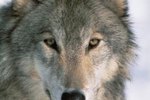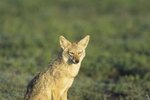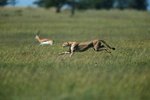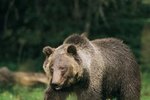
Spotted hyenas live throughout sub-Saharan Africa. These fairly common carnivores have adapted to many different habitats across the continent, including deserts, savannas and forests. Among the most social of carnivorous species, hyenas congregate in clans that may have as many as 80 members. Clans rarely act as a unit, however, and hyenas typically move about in smaller groups of two to five clan members as they go about their daily activities.
Sleep
Like many other African carnivores, hyenas typically rest during the hottest hours of the day, conducting most of their activity in the hours around dawn and dusk. When resting they can be found lying around the communal den. Cubs spend most of their time sleeping inside the dens, while adults lay outside and mothers guard their cubs from the den's entrance. Unless a longer foraging trip takes them far away from the den, most of the clan members regroup at the communal den after their dusk excursions.
Hunt
Popular media may portray hyenas as cowardly scavengers, but they actively hunt more frequently than they scavenge, killing as much as 95 percent of their food. While they prefer plant-eating mammals such as antelopes, zebras and warthogs, hyenas aren't picky eaters and consume all sorts of animals if the opportunity arises. They hunt primarily during the day, detecting prey using their keen sense of sight as well as hearing and smell. Although they occasionally ambush prey, their most common method of hunting involves intercepting a herd. Hyenas isolate an individual and chase it down, often pursuing their target at high speed for long distances.
Commute
Because hyenas prefer to prey on migrating herd animals, small groups frequently leave their clan's territory to distant locations where herds gather. These commutes may last anywhere from three to ten days. This commuting behavior enables hyenas to live in larger clans than their territory would otherwise support. Commuters often travel through the territories of other hyena clans; however, hyenas recognize the difference between groups that are just passing through and groups that are actively hunting. Although very territorial, hyenas tend to leave commuting groups alone, and aggression against them is rare.
Defend Territory
Hyenas are extremely territorial, and have numerous methods for marking and defending their turf. They use vocalizations both to warn non-resident interlopers of their territorial claim and to call other clan members to the scene if a stranger refuses to yield. Frequent scent-marking establishes the boundaries of a clan's claimed territory, and the clans establish communal latrines at the territory's fringes to demarcate boundaries as well. Small groups of clan members form border patrols and walk the boundaries day and night. Boundary disputes between rival clans are common, especially as clans grow and seek to claim larger territories.
Socialize
Hyenas have perhaps the most complex social behavior of any carnivore. Unlike most predatory species, they live in large, female-dominated clans with a strict matrilineal hierarchy. Depending on the group's overall size, there may be several hierarchical lines within a single clan. All female clan members, even juveniles, are dominant over male clan members. Social politics rule hyena clans, with individuals forming alliances with other clan members and coalitions between various small groups. Greeting rituals and social behaviors take up a good portion of the day for hyenas.
References
Photo Credits
-
Tom Brakefield/Stockbyte/Getty Images
Writer Bio
Jennifer Mueller began writing and editing professionally in 1995, when she became sports editor of her university's newspaper while also writing a bi-monthly general interest column for an independent tourist publication. Mueller holds a Bachelor of Arts in political science from the University of North Carolina at Asheville and a Juris Doctor from Indiana University Maurer School of Law.




